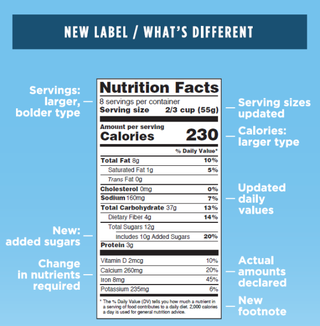Diet
What is the Decision-Making Science Behind Nutrition Labels?
The FDA designs nutrition labels to help us make healthy food choices - but how?
Posted April 14, 2018

How do you decide what food to purchase for yourself and your family? This relatively simple question involves mental calculations that take into account multiple streams of information including personal preferences and desires, product recommendations from others, manipulations by marketers and advertising, and advice from health professionals. Here is some help with the last category.

The U.S. Food and Drug Administration (FDA) announced a new label design for nutrition facts back in 2016. The goal is to make new scientific findings more visible to consumers by highlighting the link between diet and chronic disorders like heart disease and obesity. The revised label should make it easier for all of us to make healthier food choices. Food manufacturers are facing a compliance date of July 26, 2018. By this summer, you should see the revamped “Nutrition Facts and Supplement Facts Label” on most food products (smaller manufacturers with annual food sales of less than $10 million will be given an additional year to comply).
Why is this happening?
The current label is more than several decades old. The FDA wants consumers to have access to information about food information that is based upon updated science, nutrition and public health recommendations, and input from expert groups. The major changes include modifying the list of required nutrients, updating the serving size requirements, and refreshing the layout of the whole display to make it easier to read.
Sugar
There is considerable evidence that among humans the desire for sugar is enormous. This evolved preference was vital to our ancestors living in environments where sugar was scarce (and salt and fat for that matter) and only found in naturally occurring foods (e.g., oranges, apples, etc.). But the world we inhabit now is modern, industrialized, and stocked with supplies of sugar, fat, and salt so vast that we can hardly imagine going a day without ingesting all three. As such, the FDA is including information about sugar (generally OK if found naturally in foods) and added sugar (not so good because it has been added in the manufacturing stage). FDA recommendation: Aim for less than 10 percent of your total daily calories from added sugars.
Realistic Serving Sizes

Traditionally, serving size information was determined by what a single baby sparrow could eat in one sitting. These numbers were then applied to all consumers regardless of body size and age. Of course, I am kidding but the spirit of the jest is that the new serving sizes will reflect what people actually eat and drink today. These numbers will appear in larger and bolder type as will the new caloric recommendations. FDA recommendation: 2,000 calories a day is used for general nutrition advice. However, your calorie needs may be higher or lower and vary according to age, gender, height, weight, and physical activity level.
Vitamins
According to scientific food consumption surveys, Americans are not getting enough Vitamin D and potassium. This is problematic because Vitamin D is critical for bone health and potassium plays a role in blood pressure. On the other hand, the frequency of Vitamin A and C deficiencies in the population has been decreasing since the 1990s. The result of all this is that manufacturers are now required to provide Vitamin D and potassium numbers, but not Vitamin A and C (although they may continue to do so voluntarily. Calcium and iron are currently required and will continue to be so.

We all make decisions about how to allocate our time, energy, and resources; this is also true for food choices. Decision making often involves combining several categories of information and giving different weights to each piece of data. For example, we might receive food recommendations from friends, family, doctors, and marketers. Some recommendations will focus on the taste while others will emphasize the health consequences. Most of us want food that tastes really really good and is really really good for our bodies. Your doctor can help you find the right balance between these two desires.
References
Center for Food Safety and Applied Nutrition. (2018). Labeling & Nutrition - Changes to the Nutrition Facts Label. https://www.fda.gov/Food/GuidanceRegulation/GuidanceDocumentsRegulatory…


